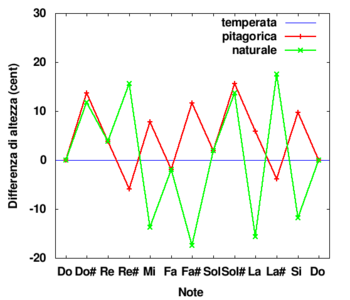All of the various musical scales present advantages and disadvantages. Complex relationships occur between the scale used by a particular civilisation, the type of music it produces, and the tastes and the ear of the people who listen to it. The characteristics of the natural, Pythagorean and temperate scales were examined on their respective pages. Here, we present two graphs that summarise their values. The first shows the pitches of the scale on the diagonal axis (the temperate scale coincides with the diagonal). The second highlights the differences between the pitches of the notes relative to the temperate scale, represented this time by the x axis.
| Comparison between the various scales |
Differences with respect to the temperate scale |

|

|
Observe that the various scales differ only by adjustments of a few cents, therefore, very little. However, these small differences can create sensitive acoustic dissonances. Remember that, in the superposition of real sounds, not only the fundamentals but also all the harmonic partials can create beats. Therefore, let's examine the particularities of the various scales (at least the most important for western music) through several simple sound examples.
| Sample |
Comment |
|
|
All the fifths of the Pythagorean scale are perfect (equal to a ratio of 3:2 or 701.995 cents), except the one that ends the scale (which, in this case, would be G#-E♭, which is not part of the sample; see the page Pythagorean scale).
|
|
|
All the fifths of the equal temperament scale are equal to 700 cents; i.e. slightly descending with respect to the 3:2 ratio of the Pythagorean scale, however, the difference is less than 2 cents and, therefore, almost imperceptible. This example should be perceived as the sampled tuned with the Pythagorean scale. |
|
|
In the natural scale, several fifths differ noticeably from the Pythagorean value of 3:2. In particular, of the three fifths audible in the example, the second has a of ratio 40:27 and differs from the perfect fifth by 21.6 cents (about one quarter of a semitone). To an ear trained in the western musical system, it would seem out of tune. |
|
|
All the chords in the progression are perfectly consonant according to natural intervals. |
|
|
Even though these are the same chords as in the preceding case, the natural scale is tuned in a far tonality (F♯) and, therefore, the chords are particularly dissonant. |
Das walt' mein Gott Vater und Gott Sohn, BWV 290 (in F major), chorale by J. S. Bach
| Sample |
Comment |
|
|
the temperate scale allows for the playing of the entire chorale without deviating too much from the intonation of the natural scale on all keyboards, no matter how far the modulations are from the initial tonality. |
|
|
The Pythagorean scale in the initial tonality is well tuned. This corresponds to having an instrument tuned in the scale in F. |
|
|
An instrument that was tuned in the Pythagorean scale in another tonality, e.g. F♯, would produce conspicuous dissonances in some places but not in others. |
|
|
The natural scale of the same tonality of the piece (F major) remains well tuned in the first measures, however, it produces some dissonance towards the end of the piece. |
|
|
The natural scale in a tonality different from that of the piece produces noticeable differences from the correct intonation and many chords that would be consonant on an instrument tuned in F become dissonant when the instrument is tuned in F♯. This means that, if we want to use the natural scale successfully, we would have to have an instrument for each tonality or play music without modulations; i.e. without ever changing tonality. |



